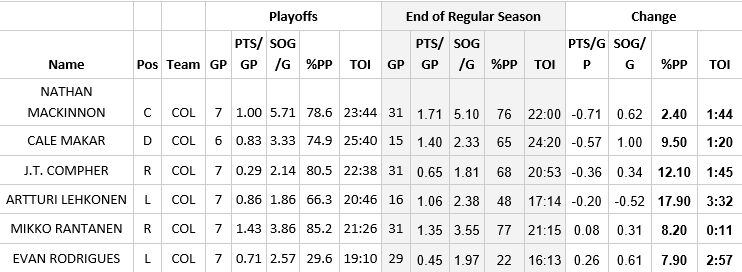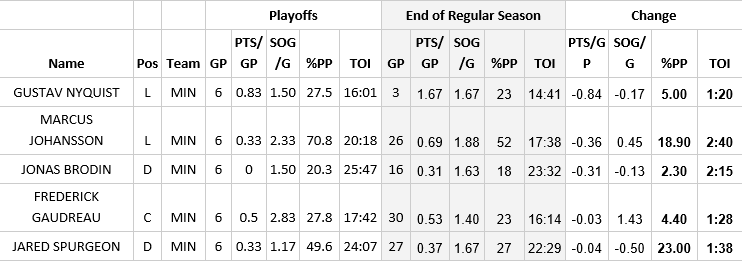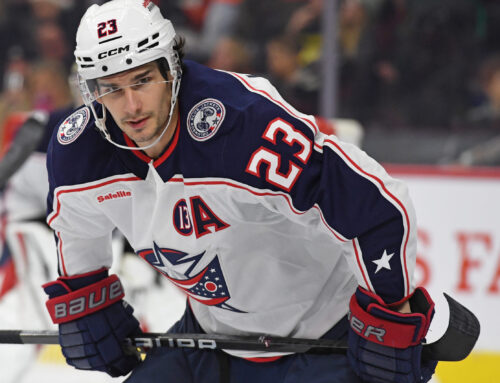The first round of the playoffs is officially wrapped, and it is time to turn our attention, at long last, to the playoff series. There are many places to get the play-by-plays, the current takes and storylines, but this is not it. We are going to dive into this extra set of games and see if there is anything to learn about a player's performance. We will go round by round and look at the eliminated teams.
We often start these things on the East Coast, so we are changing it up. In case anyone needs a little reminding, the teams that were eliminated out west were Colorado, Minnesota, LA, and Winnipeg. We are going to take a look at these four teams and focus on deployment. It is such a small sample size that we are not going to read too much into point paces, shot rates, etc. but instead look at how players were utilized in these win-or-go-home series. Doing so might give us a bit of insight into how coaches view certain players and who might be primed for a different role next season compared to this one. This is also the playoffs so to some extent we would assume that a team's top players see a bit of an increase while some depth players might fall off a bit.
Caveat time for all of these first-round exits. They all lost. In the first round. That means small sample sizes of course, but it also means that what the team/coach did didn't really work so there will be less motivation to build on it for next year.
And now on to the process. We will be looking at deployment and, more specifically power-play ice time percentage (PPTOI%) and total time on ice. We will be using percent as overtime games can add significant time to a player's overall count without changing that player's real deployment opportunity. In order to get this data, we will be running a Big Board report for the playoffs and comparing that to a second custom Big Board report for the last two months of the regular season. That comparison will tell us which players have gained or lost time between these two samples.
The following tables can be a little bit cumbersome, but we are looking at four data points from two different time periods. We have basic scoring data (points per game, and shots per game), then basic time on ice data (percent of the power-play, and total time on ice). The first white section of the table is basic player information as well as their performance in the playoffs. The gray section is the player's performance during the last two months of the regular season, and the final white section is the difference between the two so we can see who lost and gained time.
First up in alphabetical order; Colorado.

This is the table of players who saw more ice time, and surprise, surprise we have Colorado’s superstars. This makes a lot of sense as Colorado faced two elimination games and relied heavily on Nathan Mackinnon, Mikko Rantanen, and Cale Makar to try and win those games. I am a bit more interested in guys like J.T. Compher, Artturi Lehkonen, and Evan Rodrigues. Sure, to some extent they are players who just happened to be in the top six (partially because of absences from Gabirel Landeskog and Valeri Nichuskin) so someone had to be out there with MacKinnon and Rantanen, but Rodriques in particular was able to take that time on ice an increase both his shot and point rates, which neither Compher nor Lehkonen achieved. In fact, Rodrigues is essentially the only player in the group who really improved his point pace. There will certainly be some moving pieces other the offseason, but Rodrigues is the one I am watching from this group.

Unsurprisingly here we see some bottom six players, and of course some D. Some of this is likely because Makar missed time during the regular season, so these players will have played a little less in his return to the playoffs. I am not going to read too much into it here. While it is maybe not a surprise, it is a disappointment to see Alex Newhook drop off. As a young player who we are hoping to see breakout losing three minutes a game on average definitely shows he does not have the coach's confidence yet.
On to LA:

Quinton Byfield was a fixture on the top line for most of the regular season, but by the end of the playoffs he had been replaced with Viktor Arvidsson so we see a big jump for Arvidsson. We also see increases for most of the top six and that includes Alex Iafallo who wasn't consistently there all season. The top line role for Arvidsson is certainly interesting, as is almost 19 minutes of ice time for Iafallo. Both are worth keeping an eye on over the summer and training camp. Adrian Kempe showed up to play too. He exceeded the pace of his career high 66-point season and was shooting more than five times a game. He was clearly treated like the breakout was real and responded. He is definitely worth keeping on the watch list going into next season.

I am not going to read too much into this list. We have Phillip Danault losing some power-play opportunities, which is likely due to even strength matchups and then young players in Gabriel Vilardi and Quinton Byfield losing out a bit too. It is disappointing that they couldn't hang onto their deployment but doesn't change the calculus on their value too much. Sean Durzi is a little troubling as he clearly couldn't be relied on. He has gotten relatively consistent deployment the past two seasons, so it isn't a five alarm fire or anything but it isn't a great sign.
And now Minnesota:

Minnesota's data is decidedly odd. Their biggest increases are D (not that unusual) and middle six forwards. We also have guys like Matt Boldy who technically increased their overall time on ice slightly but lost out on a little power-play percentage. Some of that could simply be sample size, or specific series context, but I think it is clear the player who benefitted the most (and not just in the playoffs). Marcus Johansson seemed to really click with Boldy when Kirill Kaprizov went out, and while his point pace slowed down in the playoffs, he is the only forward whose time on ice, power-play percentage, and shot rate increased. Clearly his utility was appreciated by the coaching staff, and he at least generated some more scoring chances with it if not actual points. Given his two-year extension he is someone I am going to be watching through summer and training camp.

One consistent theme here is that all of the potentially offensive players seem to have lost power-play time. I mentioned Boldy above but the same is true (to a larger extent) for Ryan Hartman and Kirill Kaprizov. They do have an increase in overall time, which certainly isn't nothing (and might be related to the double overtime game), but for some reason they are losing out on the power-play. Again, it is hard to read too much into these numbers. For Kaprizov at least it is very unlikely he will see anything but top deployment. Hartman is a question mark as his 23 percent of the total power-play time is hardly encouraging, but it isn't like he was seeing much at the end of the season anyway.
Last but not least, Winnipeg.

This one was sort of a mess. Almost all of the players who played the five games saw increases in ice time though there were no extra overtime minutes. Given a shakeup is likely in order during the offseason, spending too much time analyzing changes at this point doesn't really make sense. It was nice to see some life from Blake Wheeler though.

Nino Niederreiter was probably the big loser in terms of deployment – basically all of it on the power play. He still managed to increase his point pace during the five game playoff series though. As stated above I am going to withhold judgment on this group until we see what shakes out over the summer.
That is all for this week.
Do your part to support organizations working to make hockey for everyone.





 FLA
FLA CHI
CHI NYR
NYR PIT
PIT L.A
L.A COL
COL CAR
CAR UTA
UTA SEA
SEA
 NYI
NYI TOR
TOR VAN
VAN
